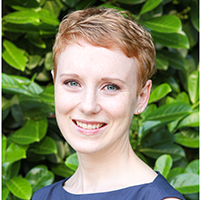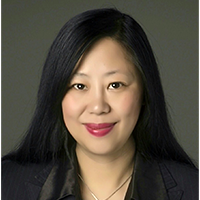Authenticity, Communication Key to Collaborating as Women in Statistics and Data Science
According to a 2020 report by KPMG, Advancing the Future of Women in Business, 75% of women in executive roles have experienced imposter syndrome. Merriam-Webster defines imposter syndrome as “a psychological condition that is characterized by persistent doubt concerning one’s abilities or accomplishments accompanied by the fear of being exposed as a fraud despite evidence of one’s ongoing success.” As statisticians who often participate in interdisciplinary and applied work, female statisticians might face challenges their male counterparts don’t when collaborating with other researchers.
Elinor Jones, Lucia Barbone, and Kelly H. Zou discussed their experiences as women collaborating with researchers and stakeholders during an hour-long panel organized by the Royal Statistical Society’s Young Statisticians Section as part of the International Day for Women in Statistics and Data Science celebration on October 10, 2023. Here are the highlights.
What are highlights in your career and past experiences that shaped your collaboration skills?
Collaboration has been the constant theme across all Jones’ jobs, despite the varying roles she’s undertaken. She has enjoyed working on a variety of projects involving collaboration with multidisciplinary teams. The impact of collaboration for Jones has been two-fold. First, these experiences have helped her build a broader base of statistical knowledge. Second, working in a collaborative environment has helped her learn soft skills, particularly communicating effectively with people from a broad range of backgrounds. Technical skills are important, but she thinks building people skills can make all the difference in accelerating one’s career.
More recently, Jones has enjoyed collaborating with those interested in statistics education through the Royal Statistical Society. They have shared their expertise and wisdom in teaching with her. She now sees her role as bringing people together to learn from a variety of educators and disseminating the latest ideas about how to best teach future statisticians so they are ready for the real world. The soft skills she honed earlier in her career, especially around communication and managing projects in multidisciplinary environments, have been invaluable in developing her work with the Royal Statistical Society.
Barbone started her career in academia while she was earning her PhD and then worked as a consultant before moving into the public sector. She started out thinking, with enough time and focus, she could ‘read up’ and ‘study’ so she was always the expert in the room, However, she quickly learned collaboration is what gives you ‘superpowers.’ Working with others helps you expand your own knowledge and skills and consider other points of view. The key is surrounding yourself with the right people, particularly those who are different and can bring a friendly challenge.
Zou realized her interest in statistics stemmed from ‘collaboration’ within her own family. Her parents told her she picked up the biggest apple from the bunch as a toddler. They suggested she “allocate them among relatives, as some are older, while others are younger.” Zou instantly realized she should pick the size of the apple based on age: the older relatives—such as her grandparents—should receive the largest ones. Zou recalled this memory so vividly because it taught her to match tasks in a systematic way.
As for recent experiences, Zou served as a judge for an early-career writing contest sponsored by the Royal Statistical Society, American Statistical Association, and Statistical Society of Australia’s joint membership magazine, Significance. The judges worked closely with the editor-in-chief to review articles about cutting-edge topics. Opinions were diverse but they created a safe space to voice them and used a rubric to finish the judging.
What are critical skills for statisticians and data scientists, especially for those who are women?
For Jones, building a good relationship with collaborators is critical. She also thinks listening and communicating are important nontechnical skills for statisticians and data scientists.
Careful listening leads to asking the right questions, and Jones is a proponent of asking lots of questions. She thinks there is no such thing as a simple or basic question when it comes to thoroughly understanding what collaborators require. And asking questions can often spark ideas.
Additionally, clear communication and genuine two-way dialogue with collaborators build trust and rapport. For example, in Jones’ experience, collaborators don’t always have clearly defined and measurable research questions. She can guide them to questions that meet their needs and are realistic from a statistical point of view when she has built a good rapport through clear communication.
Barbone agrees listening and asking questions are important skills for anyone working in statistics and data science. This is particularly true when working on multidisciplinary teams, where much can be ‘lost in translation.’ For instance, simple words such as “variable” can have different meanings in different industries. Barbone realizes one can feel awkward asking questions that appear basic or obvious, but her experience is that those questions can lead to success.
Indeed, Zou learned partnerships and collaborations aren’t always the same when she chaired the Statistical Partnerships Among Academe, Industry, and Government Award committee. Partnerships sometimes take place across sectors or between organizations, whereas collaborations can be internal or external to an organization.
Zou also considers being able to clarify roles and responsibilities, optimize task assignment, and negotiate to be critical skills. She wrote about these in a book chapter titled “To Be or Not To Be Bold: Effective Leadership in Various Individual, Cultural, and Organizational Context” that appeared in the book Leadership and Women in Statistics.
Have you encountered challenges or difficulties in a multidisciplinary and multi-stakeholder environment? If so, were you able to overcome them?
According to Jones, the biggest difficulty she has faced is managing expectations and occasionally having to firmly explain why something isn’t reasonable (e.g., timeframe), relevant (e.g., won’t answer the research questions of interest), or right (e.g., inappropriate method or interpretation). At the start of her career, she found it hard to stand her ground.
Jones found talking to other statisticians—especially women—helpful. She suggests having a mentor, no matter your career stage. With appropriate support and encouragement, she thinks gaining confidence in technical and interpersonal skills will follow.
Barbone reiterated the importance of listening and asking questions to overcome challenges. She also suggests finding a mentor—who can discuss their own past challenges and what they did to overcome them—at every stage of your career. Additionally, she said it is essential to reflect on what has been learned from every experience, successful or not.
Finally, Zou noted ethics must be followed, and nuances—even grey areas—can make collaborating challenging. In addition, global data privacy rules require in-depth knowledge. Thus, being able to communicate with stakeholders is necessary.
Any career tips to share with other women in statistics and data science?
Jones’ biggest career tip was to talk to people, though she recognizes this is often difficult if networking is your idea of a nightmare. She recommended joining and volunteering within professional societies, particularly if an opportunity of interest comes up. Recalling when she put herself forward for opportunities that scared her, she said even those that didn’t work out opened other doors. On the other hand, Jones warns against taking on too much, which is why it’s important to only choose opportunities of interest to you.
Barbone advised identifying your strengths and weaknesses. Asking others is a good way to pinpoint blind spots, she said, especially if you ask specific questions. Once you know those, Barbone recommended learning how to leverage them. For example, someone who is confident in meetings and able to easily speak in front of senior colleagues might support those who struggle with this ability by helping them prepare for a presentation.
Zou recommended playing an indispensable role in projects, volunteering to help with conceptualization, and being organized. Further, she encouraged walking in another person’s (or function’s) shoes when establishing and working on a collaborative team.
What are your final remarks about collaborating as women in statistics and data science?
Jones said being yourself is the path of least resistance in the long run. Being authentic helps build genuine collaborative relationships. She also recommended viewing experiences—positive or negative—as serving a purpose and looking after the next generation of statisticians and data scientists as you gain experience.
Barbone wholeheartedly agreed. She said it is not sustainable to change who you are to achieve a goal. Your core values and traits are what bring value to others, and you can use those values and traits to support others on their path.
Finally, Zou quoted Helen Keller: “Alone we can do so little; together we can do so much.”
Editor’s Note: The views expressed are the authors’ and do not necessarily represent those of their employers.





















Leave your response!